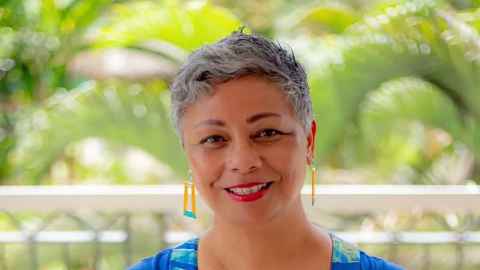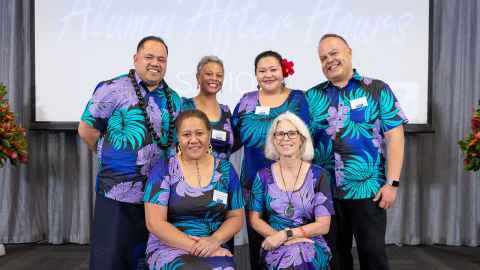Kim Meredith, a proud descendant from the atoll of Fakaofo in Tokelau, is a passionate advocate for Pacific language revitalisation.

As Waipapa Taumata Rau, University of Auckland's Pacific Media Adviser, Kim Meredith (Fakaofo in Tokelau, and Togafuafua, Fuipu'a in Sāmoa) focuses on elevating the mana of Pacific research and communities - and language revitalisation plays a big part.
But this week carries special significance for her. With Tokelauan Language Week in full swing, Kim is embracing this year's theme: "Tokelau, tāofi mau tau aganuku, ko tō pale tēnā - Tokelau, holdfast to your culture, that is your crown." For Kim, it's a powerful reminder of why Gagana Tokelau (the Tokelauan language) must thrive.
She says language is more than just words to many Tokelauans, it's a way to stay connected to their roots.
"I feel like I'm just beginning my journey with Gagana Tokelau, though I have a better grasp of Gagana Sāmoa. Learning Tokelauan is like knowing the tune of a song but still searching for the words," she explains.
Kim's journey is even more challenging given that Tokelau is so small, with just over 1,500 people still on the islands, while 7,000 call New Zealand home, primarily in Tāmaki Makaurau and Pōneke.
"Our language is at risk, labelled 'severely endangered' by UNESCO. Fewer than 5,000 people speak Tokelauan worldwide, so the fight to keep it alive is real," she says.
The remoteness of the islands also makes it difficult to sustain large populations, leading to limited resources and intentional population control to maintain a sustainable way of life.
Away from her homeland, Kim recalls learning Tokelauan words with her grandmother, Akenese Pereira, whose patience and encouragement made all the difference.

"My grandmother would patiently encourage me to try new words. As a learner, you feel vulnerable, but she made it feel okay. She'd just be there, supporting me, no judgment."
Kim believes that even speaking just a little Tokelauan bridges gaps across generations and strengthens connections with family and culture. The commitment to honour the language goes beyond vocabulary, it's about staying connected to the roots and history. "It's either use it or lose it," she says.
"What's difficult about learning is the vulnerability in trying," she admits. "You catch yourself waiting for people to correct you, or even worse, laugh at you. But then you remember the act of speaking your language, despite proficiency, immediately connects you to your family, your culture, and your history. That's so special and empowering."
"My grandmother had a huge influence on my life; she was definitely one of my heroes. From her, I learned the value of compassion and the importance of community-a core value for Tokelau."
Facts about Tokelau:
1. Tokelau is a leader in renewable energy: The entire nation (combined 12 square kms) is the first 100 per cent solar-powered nation in the world. This sustainability effort marked a significant step for small island nations striving for energy independence.
2. A three-atoll nation: Tokelau consists of three small coral atolls-Atafu, Nukunonu, and Fakaofo. These islands are spread across roughly 170 kilometers of ocean, with no flights between them; travel is by boat only, a journey that can take up to 24 hours from one atoll to another.
3. Traditional "Inati" sharing system: The Tokelauan custom of "Inati" ensures that resources, especially fish, are distributed equitably within the community. This communal sharing system is a foundation of Tokelauan culture and supports a close-knit social structure.
4. Electoral system: Tokelau has no political parties. Leadership is based on traditional structures, with each atoll governed by its council of elders, or Taupulega, which selects a Ulu-o-Tokelau (head of Tokelau) annually on a rotating basis among the atolls.
5. Population: Around 80 per cent of all Tokelauans live outside Tokelau, primarily in Aotearoa, New Zealand. This diaspora community plays a crucial role in sustaining and sharing Tokelauan language and culture internationally.






